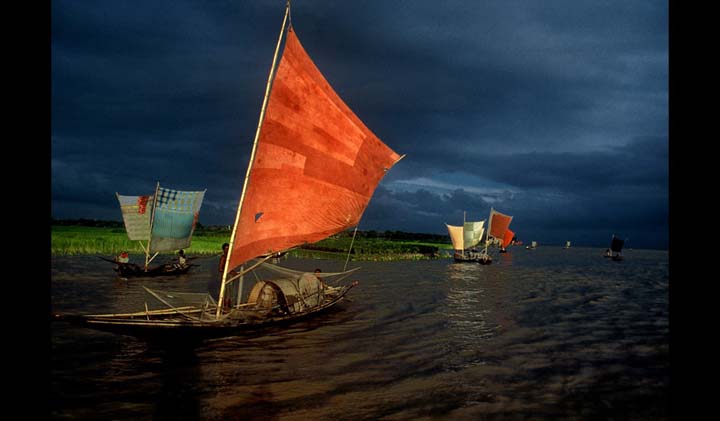Shahidul Alam: Images of Change
By Peggy Roalf Monday July 9, 2012

Journalism in this age of conflict continues to be biased towards a western and white point of view when, in fact, most of the current conflicts and unrest occur in regions that are non-western and non-white. Even the terminology for these places has evolved along lines that have little to do with realities.
For example, Mao Zedong?s term ?the Third World,? coined when he proclaimed the Peoples? Republic of China in 1949, but later viewed by journalists and policy makers as somewhat restrictive, became ?Less Developed Countries,? or LDCs. It was subsequently modified to the more exclusive ?Less Economically Developed Countries,? or LEDCs, to signify the most impoverished. When it comes to the people who live in these countries, however, the terms are irrelevant except to organizations such as the United Nations and the World Bank, whose work requires monetizing the circumstances of poverty.
It seems that the imbalance, at least in terminology, has a chance to be reset with the emergence of the Majority World Photo Agency in London. It was founded in 2010 by the Bangladeshi photographer, journalist, and writer Shahidul Alam, who long ago began advocating for the term ?majority world? to replace LDC; in his words, “it defines the community in terms of what it is, rather than what it lacks.”
Alam and his co-organizers at Majority World Photo say that it is not so much a new agency but instead a social enterprise that works with photographers from Asia, Africa, Latin America and the Middle East. They bring a local vision forward, in the process bridging the gap between photographers from emerging countries and image buyers from developed countries. Because they are not enmeshed by cultural clich?s or image saturation, they say, Majority World photographers allow the majority world to speak visually for itself. Their local knowledge and access are hinged to the ideal that their stories will not be misread; and that their stories will be about people, not numbers.
During the early 1990s, the Western educated Alam returned to Dhaka to do the work that has become his life: creating ?Images for Change.? He founded the Drik Photo Agency, Library, and Gallery, where he hosted the 1993 World Press Photo exhibition. Drawing upon the talented local photographers contributing to Drik (which in Sanskrit means ?vision? or ?philosophy?), he founded the biennial Chobi Mela International Photography Festival in 2000. The seventh installation is scheduled for 2013, with submissions due at the end of July 2012.
Alam is something of a force of nature when it comes to creating outlets for what he has coined ?Fair Trade Photography.? He has written, ?As a journalist, your only space is at the edge. You have to be constantly feeling the heat. Go back one more step, and you may cease to be effective. There are no safe options, and no prizes for popularity. If you?re not making certain people uncomfortable by your presence, you must be doing something wrong. The struggle for change is a never-ending process that requires you to be constantly alert, and forever swimming against the current. It is a lonely, stressful, tiring and immensely gratifying journey.?
This week, the Guardian Gallery in London will open the exhibition Insider, Outsider? on Thursday, July 12 from 7 to 9 pm. The show features work by 17 photographers from Africa, Asia, Latin America and the Middle East; the gallery is located in the Guardian?s headquarters at King?s Place, London N1 9GU. RSVP Steph Osborn. Read an interview with Shahidul Alam by Sarah Phillips in the Guardian. Read a review of his recent book, My Journey As Witness, in La Lettre du Photographie. Read a DART feature on the 2008 Chobi Mela International Photography Festival posted from the ground by Brian Palmer. Above: Shahidul Alam, Ilish fishing on the river Brahmaputra, Bangladesh.

[…] There is an almost exact mirror image between where NGOs are headquartered and where the people they serve live. 72% of the NGOs are headquartered in the western world while 79% of their activity takes place in?the majority world. […]
[…] There is an almost exact mirror image between where NGOs are headquartered and where the people they serve live. 72% of the NGOs are headquartered in the western world while 79% of their activity takes place in Majority World. […]
[…] similarly disturbing trends. Though 78% of the activities of the NGOs listed take place in the majority world, the ranking remains skewed towards NGOs headquartered in the West (64%). This once again sends […]
[…] similarly disturbing trends. Though 78% of the activities of the NGOs listed take place in the majority world, the ranking remains skewed towards NGOs headquartered in the West (64%). This once again sends […]
[…] similarly disturbing trends. Though 78% of the activities of the NGOs listed take place in the?majority world, the?ranking remains skewed towards NGOs headquartered in the West […]
[…] igualmente preocupantes. Aunque el 78% de las actividades de las ONG enumeradas se realizan en la mayor parte del mundo, la clasificaci?n sigue estando muy sesgada a favor de las ONG occidentales (64%). Una vez m?s […]
[…] disturbing trends. Though 78 percent of the activities of the NGOs listed take place in the?majority world, the?ranking remains skewed towards NGOs headquartered in the West (64 percent). This once again […]
[…] disturbing trends. Though 78 percent of the activities of the NGOs listed take place in the majority world, the ranking remains skewed towards NGOs headquartered in the West (64 percent). This once again […]